Music 7
Media and technology
Further information: Computer music and Music technology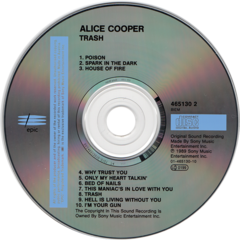 Compact Disc Digital Audio (CD-DA) revolutionized audio music formatting. It allowed for music to be played portably without the need to rewind a series of tape. The CD surpassed LP sales in 1988, and cassette tapes in 1991. By 1999, the CD accounted for 87.9% of the entire market share in regard to music sales.[145]
Compact Disc Digital Audio (CD-DA) revolutionized audio music formatting. It allowed for music to be played portably without the need to rewind a series of tape. The CD surpassed LP sales in 1988, and cassette tapes in 1991. By 1999, the CD accounted for 87.9% of the entire market share in regard to music sales.[145]
Since the 20th century, live music can be broadcast over the radio, television or the Internet, or recorded and listened to on a CD player or MP3 player.
In the early 20th century (in the late 1920s), as talking pictures emerged in the early 20th century, with their prerecorded musical tracks, an increasing number of moviehouse orchestra musicians found themselves out of work.[146] During the 1920s, live musical performances by orchestras, pianists, and theater organists were common at first-run theaters.[147] With the coming of the talking motion pictures, those featured performances were largely eliminated. The American Federation of Musicians (AFM) took out newspaper advertisements protesting the replacement of live musicians with mechanical playing devices. One 1929 ad that appeared in the Pittsburgh Press features an image of a can labeled "Canned Music / Big Noise Brand / Guaranteed to Produce No Intellectual or Emotional Reaction Whatever"[148]
Sometimes, live performances incorporate prerecorded sounds. For example, a disc jockey uses disc records for scratching, and some 20th-century works have a solo for an instrument or voice that is performed along with music that is prerecorded onto a tape. Some pop bands use recorded backing tracks. Computers and many keyboards can be programmed to produce and play Musical Instrument Digital Interface (MIDI) music. Audiences can also become performers by participating in karaoke, an activity of Japanese origin centered on a device that plays voice-eliminated versions of well-known songs. Most karaoke machines also have video screens that show lyrics to songs being performed; performers can follow the lyrics as they sing over the instrumental tracks.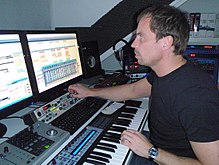 Music production in the 2000s using a digital audio workstation (DAW) with an electronic keyboard and a multi-monitor set-up
Music production in the 2000s using a digital audio workstation (DAW) with an electronic keyboard and a multi-monitor set-up
The advent of the Internet and widespread high-speed broadband access has transformed the experience of music, partly through the increased ease of access to recordings of music via streaming video and vastly increased choice of music for consumers. Another effect of the Internet arose with online communities and social media websites like YouTube and Facebook, a social networking service. These sites make it easier for aspiring singers and amateur bands to distribute videos of their songs, connect with other musicians, and gain audience interest. Professional musicians also use YouTube as a free publisher of promotional material. YouTube users, for example, no longer only download and listen to MP3s, but also actively create their own. According to Don Tapscott and Anthony D. Williams, in their book Wikinomics, there has been a shift from a traditional consumer role to what they call a "prosumer" role, a consumer who both creates content and consumes. Manifestations of this in music include the production of mashes, remixes, and music videos by fans.[149]
Education
Further information: Music education
Non-institutional
 A Suzuki violin recital with students of varying ages
A Suzuki violin recital with students of varying ages
The incorporation of music into general education from preschool to post secondary education, is common in North America and Europe. Involvement in playing and singing music is thought to teach basic skills such as concentration, counting, listening, and cooperation while also promoting understanding of language, improving the ability to recall information, and creating an environment more conducive to learning in other areas.[150] In elementary schools, children often learn to play instruments such as the recorder, sing in small choirs, and learn about the history of Western art music and traditional music. Some elementary school children also learn about popular music styles. In religious schools, children sing hymns and other religious music. In secondary schools (and less commonly in elementary schools), students may have the opportunity to perform in some types of musical ensembles, such as choirs (a group of singers), marching bands, concert bands, jazz bands, or orchestras. In some school systems, music lessons on how to play instruments may be provided. Some students also take private music lessons after school with a singing teacher or instrument teacher. Amateur musicians typically learn basic musical rudiments (e.g., learning about musical notation for musical scales and rhythms) and beginner- to intermediate-level singing or instrument-playing techniques.
At the university level, students in most arts and humanities programs can receive credit for taking a few music courses, which typically take the form of an overview course on the history of music, or a music appreciation course that focuses on listening to music and learning about different musical styles. In addition, most North American and European universities have some types of musical ensembles that students in arts and humanities are able to participate in, such as choirs, marching bands, concert bands, or orchestras. The study of Western art music is increasingly common outside of North America and Europe, such as the Indonesian Institute of the Arts in Yogyakarta, Indonesia, or the classical music programs that are available in Asian countries such as South Korea, Japan, and China. At the same time, Western universities and colleges are widening their curriculum to include music of non-Western cultures, such as the music of Africa or Bali (e.g. Gamelan music).
Institutional
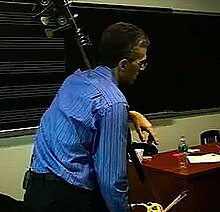 Manhattan School of Music professor and professional double bass player Timothy Cobb teaching a bass lesson in the late 2000s. His bass has a low C extension with a metal "machine" with buttons for playing the pitches on the extension.
Manhattan School of Music professor and professional double bass player Timothy Cobb teaching a bass lesson in the late 2000s. His bass has a low C extension with a metal "machine" with buttons for playing the pitches on the extension.
People aiming to become professional musicians, singers, composers, songwriters, music teachers and practitioners of other music-related professions such as music history professors, sound engineers, and so on study in specialized post-secondary programs offered by colleges, universities and music conservatories. Some institutions that train individuals for careers in music offer training in a wide range of professions, as is the case with many of the top U.S. universities, which offer degrees in music performance (including singing and playing instruments), music history, music theory, music composition, music education (for individuals aiming to become elementary or high school music teachers) and, in some cases, conducting. On the other hand, some small colleges may only offer training in a single profession (e.g., sound recording).
While most university and conservatory music programs focus on training students in classical music, there are universities and colleges that train musicians for careers as jazz or popular music musicians and composers, with notable U.S. examples including the Manhattan School of Music and the Berklee College of Music. Two schools in Canada which offer professional jazz training are McGill University and Humber College. Individuals aiming at careers in some types of music, such as heavy metal music, country music or blues are unlikely to become professionals by completing degrees or diplomas. Instead, they typically learn about their style of music by singing or playing in bands (often beginning in amateur bands, cover bands and tribute bands), studying recordings on DVD and the Internet, and working with already-established professionals in their style of music, either through informal mentoring or regular music lessons. Since the 2000s, the increasing popularity and availability of Internet forums and YouTube "how-to" videos have enabled singers and musicians from metal, blues and similar genres to improve their skills. Many pop, rock and country singers train informally with vocal coaches and voice teachers.[151][152]
Academic study
Musicology
Main article: Musicology
Musicology, the academic study of music, is studied in universities and music conservatories. The earliest definitions from the 19th century defined three sub-disciplines of musicology: systematic musicology, historical musicology, and comparative musicology or ethnomusicology. In 2010-era scholarship, one is more likely to encounter a division into music theory, music history, and ethnomusicology. Research in musicology has often been enriched by cross-disciplinary work, for example in the field of psychoacoustics. The study of music of non-Western cultures, and cultural study of music, is called ethnomusicology. Students can pursue study of musicology, ethnomusicology, music history, and music theory through different types of degrees, including bachelor's, master's and PhD.[153][154][155]
Music theory
Main article: Music theory
Music theory is the study of music, generally in a highly technical manner outside of other disciplines. More broadly it refers to any study of music, usually related in some form with compositional concerns, and may include mathematics, physics, and anthropology. What is most commonly taught in beginning music theory classes are guidelines to write in the style of the common practice period, or tonal music. Theory, even of music of the common practice period, may take other forms.[156] Musical set theory is the application of mathematical set theory to music, first applied to atonal music. Speculative music theory, contrasted with analytic music theory, is devoted to the analysis and synthesis of music materials, for example tuning systems, generally as preparation for composition.[157]
Zoomusicology
Main article: Zoomusicology
Zoomusicology is the study of the music of non-human animals, or the musical aspects of sounds produced by non-human animals. As George Herzog (1941) asked, "do animals have music?" François-Bernard Mâche's Musique, mythe, nature, ou les Dauphins d'Arion (1983), a study of "ornitho-musicology" using a technique of Nicolas Ruwet's Language, musique, poésie (1972) paradigmatic segmentation analysis, shows that bird songs are organised according to a repetition-transformation principle. Jean-Jacques Nattiez (1990), argues that "in the last analysis, it is a human being who decides what is and is not musical, even when the sound is not of human origin. If we acknowledge that sound is not organised and conceptualised (that is, made to form music) merely by its producer, but by the mind that perceives it, then music is uniquely human."[158]
Ethnomusicology
Main article: Ethnomusicology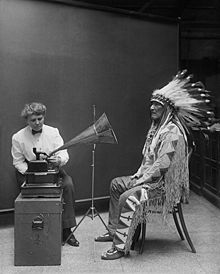 Ethnomusicologist Frances Densmore recording Blackfoot chief Mountain Chief for the Bureau of American Ethnology (1916)
Ethnomusicologist Frances Densmore recording Blackfoot chief Mountain Chief for the Bureau of American Ethnology (1916)
In the West, much of the history of music that is taught deals with the Western civilization's art music, known as classical music. The history of music in non-Western cultures ("world music" or the field of "ethnomusicology") is also taught in Western universities. This includes the documented classical traditions of Asian countries outside the influence of Western Europe, as well as the folk or indigenous music of various other cultures. Popular or folk styles of music in non-Western countries varied from culture to culture, and period to period. Different cultures emphasised different instruments, techniques, singing styles and uses for music. Music has been used for entertainment, ceremonies, rituals, religious purposes and for practical and artistic communication. Non-Western music has also been used for propaganda purposes, as was the case with Chinese opera during the Cultural Revolution.
There is a host of music classifications for non-Western music, many of which are caught up in the argument over the definition of music. Among the largest of these is the division between classical music (or "art" music), and popular music (or commercial music – including non-Western styles of rock, country, and pop music-related styles). Some genres do not fit neatly into one of these "big two" classifications, (such as folk music, world music, or jazz-related music).
As world cultures have come into greater global contact, their indigenous musical styles have often merged with other styles, which produces new styles. For example, the United States bluegrass style contains elements from Anglo-Irish, Scottish, Irish, German and African instrumental and vocal traditions, which were able to fuse in the United States' multi-ethnic "melting pot" society. Some types of world music contain a mixture of non-Western indigenous styles with Western pop music elements. Genres of music are determined as much by tradition and presentation as by the actual music. Some works, like George Gershwin's Rhapsody in Blue, are claimed by both jazz and classical music, while Gershwin's Porgy and Bess and Leonard Bernstein's West Side Story are claimed by both opera and the Broadway musical tradition. Many music festivals for non-Western music, include bands and singers from a particular musical genre, such as world music.[159][160]
Indian music, for example, is one of the oldest and longest living types of music, and is still widely heard and performed in South Asia, as well as internationally (especially since the 1960s). Indian music has mainly three forms of classical music, Hindustani, Carnatic, and Dhrupad styles. It has also a large repertoire of styles, which involve only percussion music such as the talavadya performances famous in South India.
Therapy
Main article: Music therapy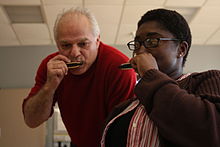 A music therapist from a "Blues in the Schools" program plays harmonica with a US Navy sailor at a Naval Therapy Center.
A music therapist from a "Blues in the Schools" program plays harmonica with a US Navy sailor at a Naval Therapy Center.
Music therapy is an interpersonal process in which a trained therapist uses music and all of its facets—physical, emotional, mental, social, aesthetic, and spiritual—to help clients to improve or maintain their health. In some instances, the client's needs are addressed directly through music; in others they are addressed through the relationships that develop between the client and therapist. Music therapy is used with individuals of all ages and with a variety of conditions, including: psychiatric disorders, medical problems, physical disabilities, sensory impairments, developmental disabilities, substance abuse issues, communication disorders, interpersonal problems, and aging. It is also used to improve learning, build self-esteem, reduce stress, support physical exercise, and facilitate a host of other health-related activities. Music therapists may encourage clients to sing, play instruments, create songs, or do other musical activities.
In the 10th century, the philosopher Al-Farabi described how vocal music can stimulate the feelings and souls of listeners.[161] Music has long been used to help people deal with their emotions. In the 17th century, the scholar Robert Burton's The Anatomy of Melancholy argued that music and dance were critical in treating mental illness, especially melancholia.[162] He noted that music has an "excellent power ...to expel many other diseases" and he called it "a sovereign remedy against despair and melancholy." He pointed out that in Antiquity, Canus, a Rhodian fiddler, used music to "make a melancholy man merry, ...a lover more enamoured, a religious man more devout."[163][164][165] In the Ottoman Empire, mental illnesses were treated with music.[166] In November 2006, Michael J. Crawford and his colleagues also found that music therapy helped schizophrenic patients.[167][168]
See also
Main articles: Outline of music and Index of music articles
 Music portal
Music portal- Glossary of music terminology
- Lists of musicians
- List of musicology topics
- Music and emotion
- Music archaeology
- Music history
- Music-specific disorders
References
Notes
- ^ A now discredited theory held by many medieval thinkers was that 'music' was descended from the Egyptian word moys, meaning water, thought to connect to Moses.[11]
- ^ For the further etymological origins, mousiké derives from the feminine form of mousikos, which is anything "pertaining to the muses", from the Ancient Greek word for Muse, Mousa.[10] There is no agreement on the origins of the word Mousa,[12] though see Muses § Etymology for proposed theories.
- ^ See Morley (2013, pp. 43–45) for a comprehensive table on all eight surviving flutes from the Geissenklösterle, Hohle Fels and Vogelherd caves







































